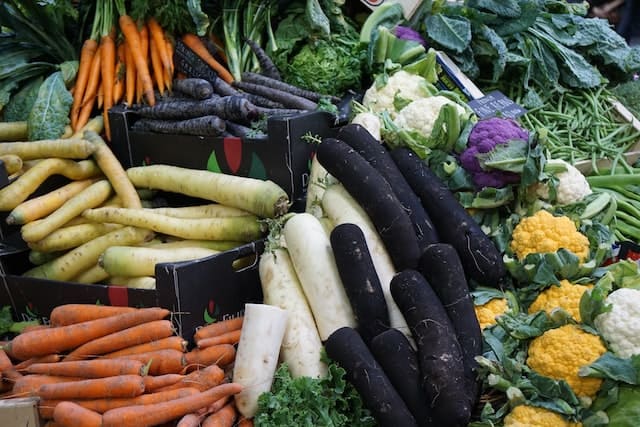If you have constantly been intimidated by the dark skinned pears of oval or tapered formation at the vegetable section of the grocery stores, now is the time to really face your fears.
Learn what black radishes are, how they taste like and the many different ways you can add them to your culinary episodes at home.

What is black radish?
Black radish is a member of the radish family alongside the red radish, green radish as well as the white radish.
Together, they form the four color variations that radishes are found in (of course with numerous color hues in-between).
Just like the white radish, black radish can appear round and spherical or tapered and elongated depending on the variety in question.
The black radish, much like other variations as well, has a sharp peppery flavor due to the high quantities of phytochemicals in it which serve as a mechanism to ward off pests and protect the plant against microorganism attack.
Depending on who you ask, the black radish might be toughest to put into culinary use (or even to consume) due to its sharper flavour in comparison to other radishes – even though the sharp flavour can be suppressed a little bit by the addition of salt.
All other health benefits as found in other radishes are provided by the black radish too.
Can you eat black radish raw?
Black radish is safe to consume raw and does not pose any threat as you might fear from the black skin.
The flavor of the black radish is described as very sharp however, which is something you should take note of before you take a full dive into the root.
When it comes to the skin of black radish, it is completely edible too and does provide some nutritional benefits.
Before consuming the skin of black radish however, make sure it looks healthy and is washed thoroughly under running water with a vegetable brush.
If you wish to peel however, then do so. Some people prefer it this way because they find the skin of the black radish really tough to chew on.
Can you eat the greens of black radish?
All parts of the radish plant from roots, leafy green to seeds are edible and are highly nutritious.
The leaves are most commonly used in salads, but roasting or sautéing them in hot oil makes them even more enjoyable. They can be sliced up and used in soups or even blended to make fruit juice or smoothies.
The seeds are boiled and then added to salads or are eaten as such when seasoned properly.
What are the ways to prepare black radish?
Salad
Of course, the number entry on the list has to be salad! Radishes are a perfect addition to salads because of their high water content which makes them crunchy and crispy.
Their undertone peppery flavor also does a complementary job with mute vegetables like carrots and cucumbers and blends well with sweet vegetables like the yellow and red bell peppers.
In salads, you can slice or grate radishes and then mix in your favourite salad dressing, chill in the refrigerator for a while and serve cold.
Marinate
Another great way to enjoy black radish is to marinate. Marination means to simply soak cut vegetables in a flavourful solution for sometime in order to infuse it with the flavours. The time for marination is typically under 24 hours, unlike in pickling where the submerged vegetables are left to sit for more than 2 days.
Some creative minds like to add colourants to the marination brine so as to give the radish flesh some color.
The marination liquid can be as simple as a brine solution (consisting of salt and water) or a more flavorful one made with flavor inducing ingredients such as dill, vinegar, pepper flakes, mustard seeds and garlic.
Braise
Braising performs a good job of destroying the “heat” producing compounds of radish that makes it spicy or sharp.
And it’s not just braising that does that, every other method of preparation that involves the use of heat does that too.
Braised rasihes can develop really complex and soothing flavors (with some not so great aromas sometimes) depending on the type of liquid used.
Sautee
Sauteeing helps to mute the sharp flavors of black radishes too.
To sautee, add little butter to a pan, add thinly sliced radishes to the pan and cook until they begin to brown.
Season as you cook with salt, pepper or whatever seasoning you think should go well. Feel free to even add herbs, cheese and cream.
Pickle them
Pickling is the more advanced form of marination. In pickling, the submerged radish is left to keep for at least 2 to 3 days in order to develop a sour flavour before it is dug into.
Because the more you leave it to store the more sour it becomes, you want to harvest your jar of pickled radish a bit early for a sweeter flavor (in case you’re not a fan of the taste of fermented vegetables).
When opting to pickle black radishes, make sure to use high quality radishes and wash them thoroughly under running water and using a vegetable brush.
You can choose to pickle with the skin on or skin off, and lastly, make sure to follow a tested recipe to avoid running into a pickled radish that has gone bad.
Roast or bake them
Roasting is that method of cooking that brings out a different dimension of flavor in foods, and it’s no different when radishes are prepared too.
When roasting radishes, they will exude a bit of smell, but it is not something you cannot handle.
Make sure to go creative when roasting radishes by brushing them with a condiment made up of miso, soy sauce, vinegar and a good roasting seasoning.
When baking, oil them so that they cook into nice chips instead. Their white insides will turn brown when they are about 7 minutes into cooking at 375°F, so make sure to leave the radishes for another 7 to 15 minutes more to become really soft. And, never forget to flip the radishes halfway through cooking so the other side gets cooked too.
Soup
Another great way to purpose lots of radishes is to make them into a soup alongside potatoes.
First start by sauteing chopped onions in butter or olive oil, then add diced potatoes and radishes without the skins on and season properly.
Cook to build some brown coloration on the potatoes and radishes then hydrate the mixture with some water and allow to come to a simmer. Now keep the mixture at simmer for about 5 minutes then add in sauce for more flavor, you can use horseradish sauce if you like.
Now bring down from the heat, let everything begin to cool, then add it to a blender and puree with light cream.
Garnish lightly with thin sliced black radish (if you like their strong flavor) or use a different vegetable or even herb instead.
How to store remnant radish
When it comes to the best way to store black radish or even radishes in general, it’s in the root cellar, and if you have one, use it instead of the refrigerator.
In a root cellar, radish will keep for many months on end in comparison to their much shorter 2 to 3 days life span at room temperature.
When stored in the refrigerator however, black radishes will keep for a couple of weeks before they begin to go bad.
To store black radishes in the refrigerator, wrap them up in perforated plastic or a breathable medium like paper towel or newspaper and store in the vegetable compartment.
How to store leftover radish
Depending on what dish you made with the radishes, the method of storing the leftover radish would differ.
For roasted, stir fried, baked or sauteed radishes, package them in an airtight container and store for no more than 3 days. Keep in the freezer for upto 4 months.
Soups can be stored in the refrigerator in a plastic container with lid for upto 4 days. They can also be frozen where they will keep indefinitely but are best purposed within the first 3 months of storage.
